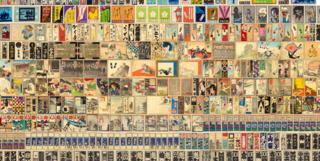-
[イベント情報]2025年10月16日(木)
立命館大学アート・リサーチセンター「日本文化資源デジタル・アーカイブ国際共同研究拠点」(ARC-iJAC)では、2026年度の国際共同研究課題〔研究費配分型/非配分型〕を公募いたします。
2026年度からは、自ら構築するデジタル・アーカイブを基盤にしてデジタル・ヒューマニティーズ型研究を推進する若手研究者の育成を重点的目標に定め、従来の国際個別テーマ型・個別テーマ型に代わり、若手研究者奨励型を新たに設置します。なお、研究システム・施設を活用できる「ARCリサーチ・スペース活用型」、ならびに「データベースシステム等による資源・成果発信型」も引き続き、年間を通して募集します。
公募する研究課題A) 若手研究者奨励型[研究費配分型]
B) ARCリサーチ・スペース活用型[研究費非配分型]
C) データベースシステム等による資源・成果発信型[研究費非配分型]
※従来の「国際共同研究課題〔ARCシステム教育実践活用〕」は、B) ARCリサーチ・スペース活用型[研究費非配分型]に統合されます。
申請方法申請者は、下記のオンラインフォームより申請を行ってください。
申請受理確認後、ご提出いただきましたメール・アドレスに電子メールをお送りします。
受理確認メールが届かない場合には、恐れいりますが、本センター事務局までご連絡ください。
応募期限(A) 若手研究者奨励型[研究費配分型])2025(令和7)年 12月 15日(月)正午(日本時間) 必着
公募要項・申請はこちら2026年度 国際共同研究 公募要項.pdf
オンラインフォーム
※若手研究者奨励型[研究費配分型]に応募される場合、下記ファイルをPDFにてオンラインフォーム上で項目に応じてアップロードしてください。
・研究および研究経費について.docx
※ARCリサーチ・スペース活用型[研究費非配分型]に応募し、研究分担者がおられる場合、下記ファイルをPDFにてオンラインフォーム上でアップロードしてください。
・研究分担者記入表.xlsx
選考及び採否通知「若手研究者奨励型」(研究費配分型)の公募は、本拠点国際共同研究課題審査委員会にて審査します。審査結果は 2026 年 3 月中旬頃に研究代表者へ電子メールにて通知します。
その他の公募につきましては、年間を通して、本拠点国際運営委員会で審査します。審査結果は2-3週間の後、電子メールにて通知します。
お問い合わせ先立命館大学 研究部 衣笠リサーチオフィス内 アート・リサーチセンター
文部科学省国際共同利用・共同研究拠点
「日本文化資源デジタル・アーカイブ国際共同研究拠点(ARC-iJAC)」事務局
担当:島田
TEL:075-465-8476(平日9:00~17:30)
E-mail:r-darc (at) st.ritsumei.ac.jp (at を @に変えてください)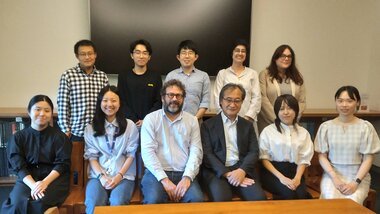
カリフォルニア大学バークレー校 日本研究センター(CJS)と、立命館大学アート・リサーチセンター(ARC) 主催のもと、第3回 合同コロキウムを開催いたしました。
日時:2025年9月17日(水) 15時から
場所: カリフォルニア大学バークレー校 東アジア図書館主催:カリフォルニア大学バークレー校 日本研究センター(CJS);立命館大学アート・リサーチセンター(ARC)
協力:立命館大学アート・リサーチセンター 文部科学省国際共同利用・共同研究拠点「日本文化資源デジタル・アーカイブ国際共同研究拠点」(※本イベントはクローズドイベントとなっておりました。)
プログラム
1.「Modern and Contemporary Kyōyaki through Kiln Tools: A Case Study of the Fireclay Saggars from the Gorōsuke Asami Kiln」
発表者:Kaneko Hina(金子ひな)
2.「The Transformation of the Tokyo Asahi Newspaper's Serialized Fiction in the Late Meiji Period (明治後期の東京朝日新聞における連載小説欄の変革)」
発表者:Jeong Subin(鄭スビン)
3.「The Borrowing and Evolution of Illustrations in Enpon Parodies of Nise Murasaki Inaka Genji
Introduction」発表者:Itami Kirari(伊丹稀星)
4.「Dusk and Dawn of Literary Friendship: Santō Kyōden at the Turn of the Nineteenth Century (文の友、暮れと明け: 十九世紀をめぐる山東京伝)」
発表者:Tang Yisheng(唐藝晟)
懇親会
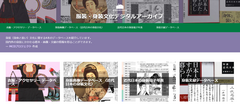
The Art Research Center (ARC), Ritsumeikan University, is pleased to share that the Shinsō Culture Digital Archive--adopted as an international joint research project by the ARC-iJAC in FY 2024 and FY 2025--has been featured on the blog of the North American Coordinating Council on Japanese Library Resources (NCC).
The Shinsō Culture Digital Archive investigates Japan's modern clothing culture through the concept of shinsō--the integration of body and clothing. Developed as part of the long-term Minpaku Costume Database Project (MCD), the archive is led by Dr. Haruko Takahashi (Visiting Researcher, National Museum of Ethnology) and realized through a cross-disciplinary collaboration that includes ARC faculty member Dr. Keiko Suzuki (Graduate School of Letters, Ritsumeikan University).
Among its four databases, the NCC blog highlights two in particular: the Chronology of Japanese Clothing Culture in the Modern Age Database, which reconstructs everyday dress and perceptions of the body from the Meiji Restoration to the end of World War II using contemporaneous newspapers, magazines, and catalogs; and the Image Database of Japanese Clothing Culture in the Modern Age, which leverages detailed illustrations from serialized novels and other materials to provide rare visual insights into styles and appearances of the time.
The ARC has supported the project by launching a dedicated portal site within the ARC Virtual Institute to enhance accessibility to these interdisciplinary resources both in Japan and internationally, aiming to broaden global engagement with Japan's clothing history and material culture.
Learn more about the project in the NCC's blog post "Japanese Studies Spotlight: Decoding Clothing Culture with the Shinsō Digital Archive," co-authored by Dr. Haruko Takahashi and Dr. Keiko Suzuki.
Explore portal site of the Shinso Culture Digital Archive in the ARC Virtual Institute: https://www.arc.ritsumei.ac.jp/lib/vm/shinsou/
カリフォルニア大学バークレー校 日本研究センター(CJS)と、立命館大学アート・リサーチセンター(ARC) 主催のもと、第3回 合同コロキウムを開催いたします。
日時:2025年9月17日(水) 15時から
場所: カリフォルニア大学バークレー校 東アジア図書館主催:カリフォルニア大学バークレー校 日本研究センター(CJS);立命館大学アート・リサーチセンター(ARC)
協力:立命館大学アート・リサーチセンター 文部科学省国際共同利用・共同研究拠点「日本文化資源デジタル・アーカイブ国際共同研究拠点」
(※本イベントはクローズドイベントとなっております。)プログラム
1.「Modern and Contemporary Kyōyaki through Kiln Tools: A Case Study of the Fireclay Saggars from the Gorōsuke Asami Kiln」
発表者:Kaneko Hina(金子ひな)
2.「The Transformation of the Tokyo Asahi Newspaper's Serialized Fiction in the Late Meiji Period (明治後期の東京朝日新聞における連載小説欄の変革)」
発表者:Jeong Subin(鄭スビン)
3.「The Borrowing and Evolution of Illustrations in Enpon Parodies of Nise Murasaki Inaka Genji
Introduction」発表者:Itami Kirari(伊丹稀星)
4.「Dusk and Dawn of Literary Friendship: Santō Kyōden at the Turn of the Nineteenth Century (文の友、暮れと明け: 十九世紀をめぐる山東京伝)」
発表者:Tang Yisheng(唐藝晟)
懇親会
In addition to its world-renowned, extensive collection of ukiyo-e prints, the Victoria & Albert Museum (V&A) in London also holds a significant, yet long-overlooked collection of Japanese illustrated books (ehon).
Originally part of the National Art Library before being moved to the V&A's Asia Department, this collection comprises more than 1,700 volumes across approximately 500 different titles, spanning the 17th to 20th centuries.
Until recently, the collection had only been partially catalogued, with no comprehensive resource available. An ongoing research and digitization collaboration between the V&A's Asia Department, the Sainsbury Institute for the Study of Japanese Arts and Cultures (SISJAC), and the Art Research Center (ARC) is addressing this gap.
The project involves digitizing the books, compiling catalogue entries, and producing bilingual records (Japanese and English) for the V&A's Explore the Collections database.
Learn more about the collection, the project's background, and its achievements in the V&A blog post "Revealing the V&A's Japanese Illustrated Book Collection" by Caroline Gill.
URL: https://www.vam.ac.uk/blog/museum-life/revealing-the-vas-japanese-illustrated-book-collectionLondon, August 2025: Prof. Ryo Akama and his digital-archiving team with
Masami Yamada (Curator, Asia Department, Victoria & Albert Museum)ARC Daysは、立命館大学アート・リサーチセンターの教員と、日本文化資源デジタル・アーカイブ国際共同研究拠点(ARC-iJAC)に採択された国際共同研究者の研究プロジェクトを発表する年に1度のイベントです。
お時間の許す限り、両日ともにご出席ください。なお、8/2の13:30からWORKSHOPを開催いたします。ぜひご参加ください。
※Workshop(くずし字講座、ビデオアーカイブ講座)
日時:2025年8⽉1⽇(金)10:30-17:30、8⽉2⽇(土) 10:00-18:30(予定)
会場:ハイブリッド開催 ARC+オンライン(ZOOM,YouTube)ARCメンバーの方は、事務局よりURLをご連絡いたします。
※ARCメンバー以外の方は Youtubeよりご参加いただけます。 こちら からご覧ください。(※一部配信出来ないプログラムもございます)お問い合わせ先:アート・リサーチセンター事務局 arc-jimu@arc.ritsumei.ac.jp
主催:立命館大学アート・リサーチセンター、文部科学省 国際共同利用・共同研究拠点「日本文化資源デジタル・アーカイブ国際共同研究拠点」、立命館大学研究拠点形成支援プログラム
【各セッションは20分以内(質疑応答を含む)で、研究代表者の先生方がプロジェクトの紹介を行います。
質疑応答は、セッションに参加するプロジェクト代表者の⽅々、その他オンラインで視聴者から出ることが予想されます。】プログラムは随時更新されます。
国際共同利用・共同研究拠点ARC-iJACのプロジェクト「滋賀県愛知川における伝統的河川管理情報のデータベース化」が協力した企画展示が開催されます。
日 時:2025年07月19日 ~ 2025年11月24日
開館時間 9時30分~17時00分(入館は16時00分まで)場 所:滋賀県立琵琶湖博物館 企画展示室
[イベント情報]2025年6月16日(月)The Art Research Center (ARC) at Ritsumeikan University is pleased to announce that more than 6,400 nōsatsu and senshafuda votive images in the University of Oregon Library's Gertrude Bass Warner Collection of Japanese Votive Slips (nōsatsu) have been made available online.
The Nōsatsu & Senshafuda University of Oregon Database can be accessed here:
https://www.dh-jac.net/db/nishikie/search_oregon.phpThe collection is also integrated into the ARC Nōsatsu Portal Database, here:
https://www.dh-jac.net/db/nishikie/search_Nosatsu.php.The University of Oregon Libraries' collection is the largest collection of Japanese shrine and temple votive slips in North America. They range in date from the 1850s to the 1930s and feature images representing a wide range of themes, from seasonal celebrations and observances, historical and fictional figures, and scenes of everyday life to objects, buildings, and landscapes. Some depict pilgrims or members of nōsatsu collecting & exchange clubs (nōsatsu-kai).
Senshafuda and nōsatsu are believed to have originated in the 18th century, as printed slips of text or images purchased by pilgrims and plastered onto walls or pillars at shrines and temples as a devotional act. They later became collectors' items, and by the end of the 19th century were actively traded in nōsatsu-kai not dissimilar to surimono poetry prints circles which were also vibrantly active at the time. (For more on the latter, see the ARC Virtual Institute "Salons and Networks in Kyoto and Osaka": https://www.arc.ritsumei.ac.jp/lib/vm/Salon/)
Most of the votive slips in the University of Oregon's collection today were originally acquired in the 1910s to 1920s by Frederick Starr (1858-1933), a professor of anthropology at the University of Chicago who reportedly became so active and prominent in nōsatsu-kai collecting & exchange clubs that he came to be known as "O-fuda Hakushi" (Dr. Votive Slips).
This digitization and database construction effort was initiated by Kevin McDowell, Japanese Studies Librarian at the University of Oregon, in 2015 and continued as an International Joint Research Project under the International Joint Digital Archiving Center for Japanese Art and Culture (ARC-iJAC) in 2020. Though the project was placed temporarily on hiatus due to the Covid-19 pandemic and other factors, we are glad to now make this significant resource available to the public. We hope this database will support future research in art history, material culture, religious studies, and related fields.
For image use beyond personal research, please consult the Reproductions and Permissions policies and contact information for Special Collections at University of Oregon Libraries: https://library.uoregon.edu/find-materials/special-collections-and-university-archives/reproductions-and-permissions.
(Some information above is drawn from: https://oregondigital.org/collections/gb-warner-nosatsu, as well as from Kevin McDowell, "Echoes of Edo in the University of Oregon's Japanese Votive Slips Collection," presentation at European Association of Japanese Resource Specialists annual conference, 2024.)
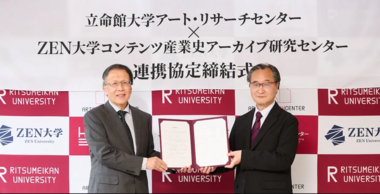
2025年6月9日、立命館大学アート・リサーチセンター(ARC)は、ZEN大学コンテンツ産業史アーカイブ研究センター(HARC)と、学術共同研究に関する連携協定を締結いたしました。
立命館大学衣笠キャンパスで行われた協定締結式には、ZEN大学HARC 細井浩一所長、ARC 赤間亮センター長(文学部)が出席しました。
この連携協定締結により、「メディア芸術コンテンツ分野における映像オーラル・ヒストリー及び同人創作コンテンツ関連資料のデジタルアーカイブ構築」 として、以下を目指します。
1)マンガ、アニメ、ゲームを中心とするメディア芸術コンテンツ分野と、IT分野、ネット文化分野で活躍した人々における「映像オーラル・ヒストリー」を収集するとともに、それらのデジタルアーカイブを構築、公開します。よって、現代日本を代表する大衆文化資料の研究資源化および組織化する 。
2)「リアルタイム・ヒストリープロジェクト」として、日本を代表する同人創作物の交流活動であるコミックマーケット関連の一次資料の学術分野での利活用を目指し、同事業におけるカタログ冊子のデジタル化と研究資源として公開、活用するための課題について検討しつつ、それらの資料を保護・保存するためにデジタルアーカイブを構築する。
ZEN大学HARCについて
2023年9月30日に設立されました。HARCは、コンテンツ産業の歴史を形作ってきたヒトやモノやコトに関わる一次資料の収集を広く深く実施し、保存するアーカイブを構築します。また、アーカイブ資料を研究や教育、事業創造など社会的な利活用のために公開していくことを使命として活動しています。
[イベント情報]2025年6月 3日(火)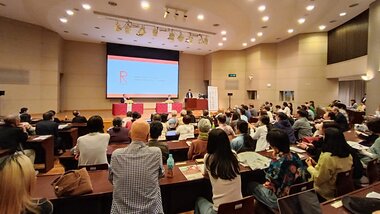
On June 1, 2025, Ritsumeikan University's Kinugasa Campus hosted the KINUGASA ART VILLAGE FESTIVAL to commemorate the 125th anniversary of the founding of the Ritsumeikan Academy.
As part of the festival, the Art Research Center (ARC) held an art dialogue titled 'Ukiyo-e and its Global Reach,' featuring two renowned ukiyo-e experts: Dr. Shugo Asano and Prof. Ryo Akama.
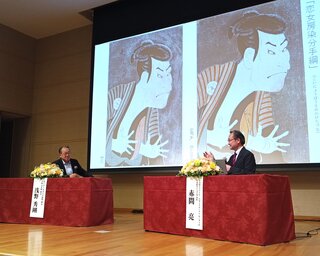
Dr. Shugo Asano serves as the President of the International Ukiyo-e Society and is the Director of both the Abeno Harukas Art Museum in Osaka and The Museum Yamato Bunkakan in Nara.
Prof. Ryo Akama, of the College of Letters at Ritsumeikan University, is the Director of the ARC and a pioneer in the digital archiving of Japanese art held in overseas collections, having spearheaded the creation of the world's largest ukiyo-e online research database.
Ukiyo-e, widely recognized through its presence on banknotes, passports, and popular TV dramas, also includes many lesser-known works that have remained 'hidden' within museum collections around the world. During their conversation, Dr. Asano and Prof. Akama highlighted the enduring appeal of ukiyo-e and discussed how masterpieces by artists such as Hokusai, Kunisada, and Kuniyoshi are exhibited not only in Japan but also in prestigious museums worldwide, including the British Museum and the Museum of Fine Arts, Boston.
Their insightful exchange offered attendees a unique opportunity to deepen their understanding of ukiyo-e's cultural significance and its far-reaching international influence.
Looking ahead, with the establishment of the College of Arts and Design on Kinugasa Campus next year--where Prof. Akama will serve as dean--Ritsumeikan University is excited to host further events that celebrate and explore Japan's extensive artistic heritage in a global context.




